Apple iPad 2 GPU Performance Explored: PowerVR SGX543MP2 Benchmarked
by Anand Lal Shimpi on March 12, 2011 3:04 PM EST- Posted in
- Smartphones
- Apple
- iPad
- GLBenchmark
- iPad 2
- Mobile
- Tablets
GLBenchmark 2.0
GLBenchmark 2.0—as its name implies—tests OpenGL ES 2.0 performance on compatible devices. The suite includes two long benchmarking scenarios with a demanding combination of OpenGL ES 2.0 effects - texture based and direct lighting, bump, environment, and radiance mapping, soft shadows, vertex shader based skinning, level of detail support, multi-pass deferred rendering, noise textures, and ETC1 texture compression.
GLBenchmark 2.0 is the best example of an even remotely current 3D game running on this class of hardware—and even then this is a stretch. If you want an idea of how the PowerVR SGX 543MP2 stacks up to the competition however, GLBenchmark 2.0 is probably going to be our best bet (at least until we get Epic to finally release an Unreal Engine benchmark).
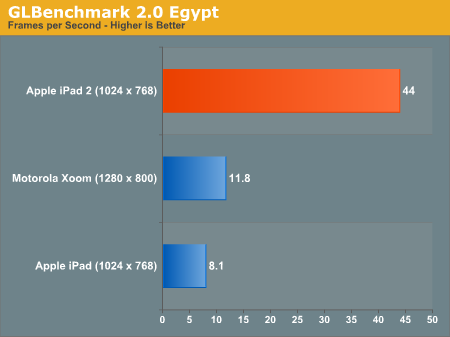
Without AA, the Egypt test runs at 5.4x the frame rate of the original iPad. It's even 3.7x the speed of the Tegra 2 in the Xoom running at 1280 x 800 (granted that's an iOS vs. Android comparison as well).
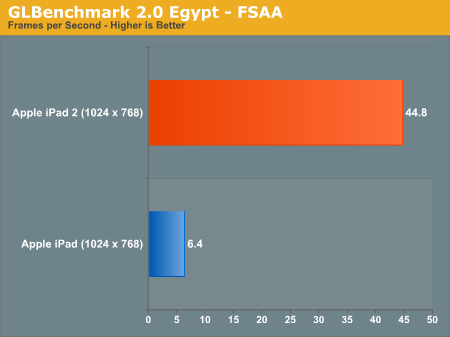
With AA enabled the iPad 2 advantage grows to 7x. In a game with the complexity of the Egypt test the original iPad wouldn't be remotely playable while the iPad 2 could run it smoothly.
The Pro test is a little more reasonable, showing a 3 - 4x increase in performance compared to the original iPad:
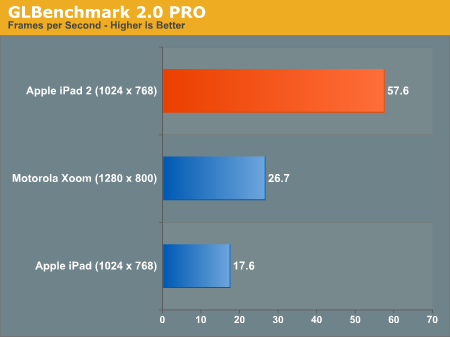
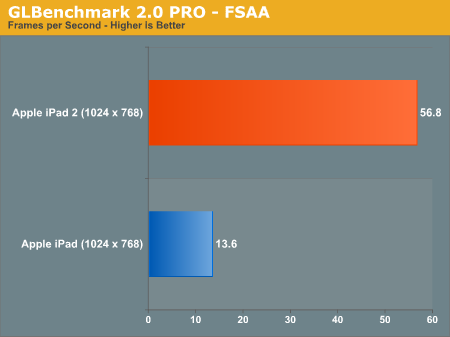
While we weren't able to reach the 9x figure claimed by Apple (I'm not sure that you'll ever see 9x running real game code), a range of 3 - 7x in GLBenchmark 2.0 is more reasonable. In practice I'd expect something less than 5x but that's nothing to complain about. We'll be doing power analysis over the weekend so expect more detail in our full review.
Putting the PowerVR SGX 543MP2 to Use: Infinity Blade
As we pointed out in our iPad 2 Preview, at least one developer already picked up on the amount of extra GPU horsepower in the new iPad 2. Epic put out an updated version of Infinity Blade with support for the iPad 2. Run it on an iPad and you'll get the same old Infinity Blade, but run it on an iPad 2 and you'll get more detail, higher resolution textures and anti-aliasing.
Remember that iPad and iPhone devices are more closed than your PC. There's no adjusting detail settings or resolution, so the target frame rate is usually what's fixed. Developers are simply able to deliver a better looking experience at roughly the same frame rate with upgraded hardware. In the case of Infinity Blade, load times are reduced thanks to the Cortex A9 CPU cores and there is some improvement in frame rate but the biggest impact comes from the improved visuals.
Below is the comparison beween Infinity Blade on the iPad and iPad 2 we ran in this morning's preview:
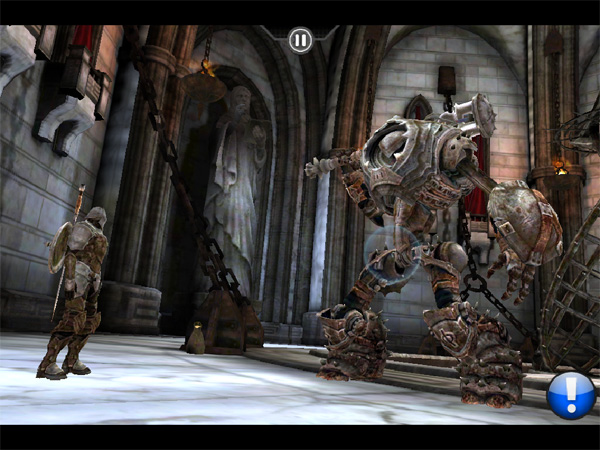
Mouse over to see Infinity Blade on the iPad 2
There's far more detail in the character models as well as the environment. Lighting looks improved and the AA is definitely appreciated.
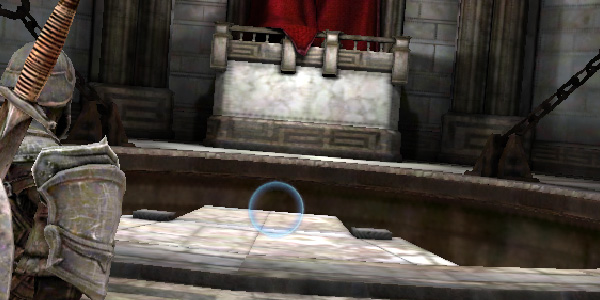
Mouse over to see Infinity Blade on the iPad 2
The gallery below has a bunch of side by side shots showing the improvements made to Infinity Blade for the iPad 2 vs. what you get when you run the game on a first generation iPad.
To Be Concluded...
We're still hard at work on our full iPad 2 review. We've got no less than four units running through battery life tests right now and there's still more to talk about in the review. We'll keep you posted, thanks for reading!

















219 Comments
View All Comments
EarthCore - Sunday, March 13, 2011 - link
How does the iPad beat a netbook when it comes to browsing when it can't display over 40% of the websites that use Java and Flash?As far as licensing media goes, netbooks can display all media a laptop can display.
iPad has restrictive media licensing policies. Try searching for a Vevo music video on the iPad. You will get ZERO results. Try the same search on a netbook on Youtube. See the difference? What koolaid are you drinking?
Real physical keyboard vs virtual keyboard, no need to explain this one. But if you really want to have a WPM typing contest on your precious iPad vs my netbook...then game on!
Lastly, I'd want to see some benchies between Intel Atom and the A5 before sheepishly saying that iPad trumps netbooks.
Jesus, the Apple fan boys have no capacity for independent thought do they?
kmmatney - Sunday, March 13, 2011 - link
For the average Joe, a tablet provides easier access to email, games and applications, and typically provides a much better web browsing experience. I don't see the point in a netbook, really - get a real notebook for real work, and use a tablet for leisure.solipsism - Sunday, March 13, 2011 - link
it’s Apple’s 3rd most profitable business segment and will likely be the 2nd most profitable sometime this year, only behind the iPhone. Apple make more profit than MS now and that is helped by additional iPad sales, not inspite of, like the loss leader “me to” products that come out each month claiming to be "<Apple product>-killers”.On top of that the iPad is the fasting selling CE and Apple made this market segment viable despite other vendors having a couple decades to figure it out. Sure, it all makes sense and seems obvious now that it was explained to you assuming Apple did nothing special here. Where was Moto, Nokia and RiM’s tablets? Where was MS’ WinMo tablet OS?
So why again do you think that that this market isn’t popular or profitable?
ncb1010 - Sunday, March 13, 2011 - link
"On top of that the iPad is the fasting selling CE"If CE = Consumer Electronic....
Kinect sold 10 million in 3 or 4 months. Quite a bit faster than iPad with 15 million in 9 months with about half in Q4.
solipsism - Monday, March 14, 2011 - link
It is sold to consumers and it does contain electronics, but it’s an accessory to a device so I don’t include that in any such listing. Do you include headphones and power adapters as CE? I surely don’t.wytworm - Monday, March 14, 2011 - link
...and yet the digitaltrends.com and the Guinness Book of World records does.http://www.digitaltrends.com/gaming/xbox-kinect-sa...
Spazweasel - Monday, March 14, 2011 - link
The "Guiness" in the "Guiness Book of World Records" is the beer company. Really.I don't think their opinion on anything other than beer is authoritative, accurate, educated, informed, or relevant. These are the same people that keep track of biggest burritos and largest tumors. Quoting them on matters of consumer electronics is like quoting the National Enquirer on... anything.
ncb1010 - Saturday, March 12, 2011 - link
27% to 73% is a 1:3 ratio...not 1:4.ncb1010 - Saturday, March 12, 2011 - link
And that is not including e-readers like the Amazon Kindle or Nook Color which I classify as a tablet. If you include that, Apple's market share dips to about 50% because of the 12 million e-readers sold in 2010.akedia - Saturday, March 12, 2011 - link
And that's not including MP3 players, smartphones, netbooks, laptops, desktops, or supercomputers, which I classify as tablets too!You're conflating two very different device categories to make the argument that a *mere* 50% market share for a single device isn't particularly significant? *slow claps* Quite the argument you make there. Quite the argument.